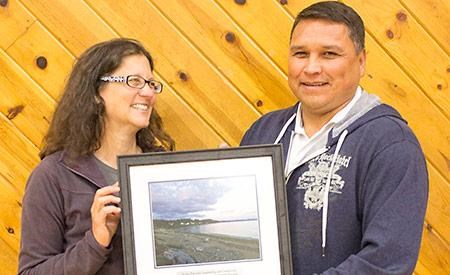Archeological researchers presented highlights from their Tla’amin (Sliammon) summer field research in an impromptu talk to the community at Salish Centre.
“You can’t keep me away from this place,” Dr. Dana Lepofsky, a Simon Fraser University professor of archaeology who has been returning to Tla’amin for the past seven years to conduct field schools for her graduate and undergraduate students.
Tla’amin (Sliammon) Nation and Simon Fraser University (SFU) entered into a partnership in 2007. They launched the Tla’amin-SFU Archaeology and Heritage Stewardship Program with the goal of giving researchers and students access to discover what they could about Tla’amin history while at the same time providing educational opportunities for students and the public.
“It was a lot of easy convergence,” Lepofsky said at the June 19 evening event.
While Tla’amin members have extensive oral knowledge of their history, the area was largely unexplored from an archaeological perspective, she added.
“The project brings together oral traditions with information from archaeological field work conducted in the summer and archival investigations,” Lepofsky said.
The archeological field school wrapped up its excavations in 2012 and has been piecing together the history of the area and its ancient inhabitants. In 2013, the researchers returned to interview elders in the community and collecting their stories.
Over the years of the field school, the archeologists started to focus their examinations on certain areas of research.
“Dogs and herring weren’t on the radar then,” said Lepofsky of the early days of the field school. “They just developed as people shared their stories with us.”
Lepofsky took the opportunity to talk about her herring research and the launch of a newly developed website which tells the story of the fish and its cultural importance on the coast to aboriginal people.
In addition to the students writing their theses, their findings will be brought together in a Tla’amin historical atlas which will provide the public with a greater understanding of the patterns of settlement over the more than 8,000 years people have lived in the area and provide a window into Tla’amin culture of the past.
Graduate students Julia Jackley, Chris Springer and Kasia Zimmerman gave what Lepofsky described as “little snapshots and snippets of what was discovered”—a small portion of the many things that students are working on, she added.
Jackley’s research looked at the archeological record around Scuttle Bay, and included interviews from elders who grew up in the area. She discovered that people have lived continuously there for at least the past 2,000 years and found evidence 4,000 years old. She found artifacts from cooking and resource processing as well as areas where at least four plank houses were located.
In every layer of earth Jackley uncovered stretching back more than 600 years she found large quantities of herring vertebrae. She also uncovered a petroglyph of two mirror image triangles carved into the stone where it is thought the plank house settlement was located.
Springer’s research also looked at settlement patterns, but he focussed his attention on Harwood Island. His findings indicated that people lived on the undeveloped island between 2,300 to 2,800 years ago and that it was not simply a place for hunting deer or collecting clams and other seafood. The island has been traditionally viewed as a place of retreat and was used in 1918 after a fire destroyed much of the village at Tla’amin.
Zimmerman talked about the importance of hunting dogs for the Tla’amin people. She tested the remains of dogs, some of which had been buried 3,500 years ago, using advanced DNA analysis to identify the breeds that were being used and how they were treated. She also interviewed elders about what they remembered growing up.
Hunting dogs were highly regarded and not only ate the same food as people—a diet high in seafood—but also were buried in a similar fashion to their owners. Zimmerman’s findings show that particular attention was given to select breeding of dogs used for hunting and were corroborated through interviews with elders.
This analysis combined with examining ancient dog mitochondrial DNA throughout the region also provides a glimpse into migration patterns, she said.
Readers can visit Lepofsky’s Herring School website at www.pacificherring.com for more information.



